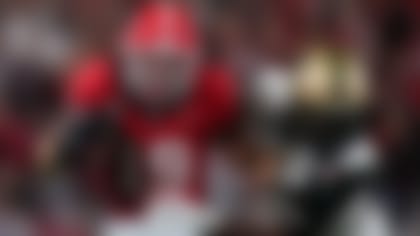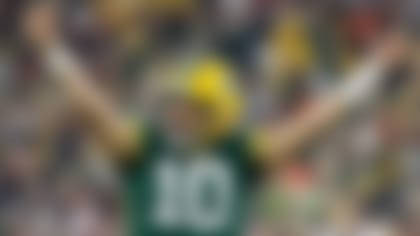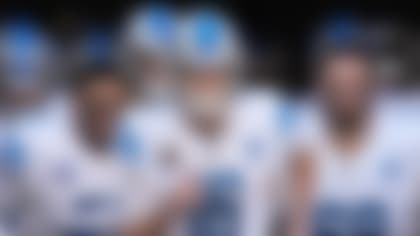Former NFL player and scout Bucky Brooks knows the ins and outs of this league, providing keen insight in his weekly notebook. The topics of this edition include:
» Is Tom Savage playoff-bound?
» Why the Pro Bowl matters to scouts.
But first, examining whether the Broncos' struggles are connected to their approach at QB ...
* * * * *
When the Denver Broncos elected to defend their Super Bowl crown without a proven commodity at quarterback, the rest of the football world looked at John Elway with a raised eyebrow. How could one of the greatest quarterbacks in NFL history view the "most important position" as just another cog in the wheel when everyone suggests that you must have an elite quarterback to compete for the Lombardi Trophy?
After watching the Broncos nearly fall out of contention for a playoff spot, the "I told you so" crowd is ready to claim victory. But I will be the first to tell you that the defending champs' plan was a solid one, and more teams should attempt to follow the blueprint when attempting to build a title contender.
Pick your jaws up from the ground; I know it might seem like a shocking idea in light of Denver's troubles, but I truly believe deemphasizing the quarterback position in order to build a balanced team that features prominent playmakers on both sides of the ball is the approach of the future. The lack of elite quarterbacks in the pipeline should prompt more teams to look for alternative approaches. The Broncos' plan was not only sensible in the short term, but it can help them remain viable contenders over the long haul.
Remember, the Broncoslost Super Bowl XLVIII despite having a high-powered offense directed by a Hall of Fame-caliber quarterback (Peyton Manning) playing at an MVP level. The offense-heavy squad lit up the scoreboard like a pinball machine and waltzed through the NFL with a "score more" philosophy -- that is, until it was bullied by a rugged Seattle Seahawks defense on Super Sunday. The 43-8 loss prompted Elway to tweak his approach, with Denver committed to building a team fueled by a dominant defense, powerful running game and efficient quarterback play.
As a result, the Broncos went on to claim Super Bowl 50 despite a pair of quarterbacks (Manning and Brock Osweiler) combining to play some of the worst football at the position that we've seen in years. Considering their success with a blueprint straight out of the 1960s -- when Vince Lombardi's Green Bay Packers dominated the league with the famed "Packer Sweep" -- it was not a surprise that the Broncos moved on from Osweiler when his price tag exceeded their budget. Nor was it a surprise when they didn't commit big bucks to the middling free-agent quarterbacks that hit the market.
Elway's sterling resume as a player and executive earned him a pass from critics when he and coach Gary Kubiak tabbed Trevor Siemian to lead the repeat run for the Broncos. But the question remained: How could the team turn to a lightly regarded late-round pick to direct another title push when the NFL game is supposed to be governed by the quarterback?
While the common narrative being floated in some circles suggests Siemian simply isn't good enough to get the job done, a quick look at the numbers rejects that notion. The second-year pro has posted a 16:8 touchdown-to-interception ratio and an 88.1 passer rating compared to a 19:23 TD-to-INT ratio and a 76.3 rating posted by his predecessors.
Sure, Siemian hasn't been the "one-man" show that would endear him to fantasy football fans, but he has proven he can play winning football at the position when asked to shoulder a heavy load. For instance, the Broncos have a 6-2 record when Siemian throws 40 or fewer passes, but they are only 1-3 when he has 40-plus attempts in a game. At this stage of his career, he is most effective as a complementary player on a team that leans on the running game and defense. When the defense is keeping the score down and the running game is effective, Siemian is a solid QB1 with the potential to grow into a Kirk Cousins-like starter.
Given that assessment, I believe the Broncos' biggest undoing this season has been their shoddy offensive-line play and an inconsistent running game. They mismanaged their offensive-line situation in the offseason, and it's hurt them immensely during the regular season. The unit has not only surrendered 40 sacks (tied for 29th), but it has failed to open holes at the point of attack on running plays. The Broncos average only 91.3 rushing yards per game, and their inability to run is directly tied to the team's disappointing record. Consider that Denver is 5-1 when rushing for 100-plus yards and 3-5 when rushing for fewer than 100 yards. Of course, the loss of C.J. Andersonto a torn meniscus in Week 7 played a role: The Broncos averaged 111.6 rushing yards with him in the lineup and have only managed 71.0 rushing yards per game since his injury.
Naturally, the analytics crowd will suggest that rushing yards don't necessarily matter, but the need to lean on the running game is part of a "slow-down" strategy that emphasizes ball control (time of possession), ball security (positive turnover margin) and stingy defense (holding opponents to 20 points or fewer). The Broncos win the overwhelming majority of the games in which they hit the mark in each of those areas. Most importantly, they are able to play without a superstar in the fold. Considering the small number of VIP quarterbacks in the NFL, more teams should adhere to this blueprint.
Let's take a deep look at the numbers and how the Broncos weren't far off with their superstar-less approach at QB. When scoring 20-plus points, the Broncos are 8-2 compared to a 0-4 record when failing to score at least 20 points. In addition, the team is unbeaten (6-0) when winning the turnover battle this season as opposed to their 1-2 and 1-4 marks, respectively, when tied or losing the turnover battle. In fact, the Broncos have won 22 straight games when they don't have a giveaway -- the longest active streak in the NFL.
Defensively, the Broncos' magic number is 20 -- that is, they're 7-2 when holding opponents to 20 points or fewer. This is consistent with their formula from 2015, when they held opponents to 18.5 points per game on the way to the Super Bowl. In fact, they're allowing less (only 18.4 points per game) in 2016. Thus, it is nearly impossible to pin the Broncos' failures on a unit that remains one of the stingiest in football.
This is why the Broncos' woes should be pinned squarely on the shoulders of the offensive line. The hodgepodge unit has failed the team in epic fashion, and everyone, including a loud and obnoxious set of defensive backs, should point the finger at the grunts in the trenches. The group hasn't played well -- and the ineptitude could've been avoided with a better offseason plan. Instead of attempting to piece together an offensive line with misfits and cast-offs, the Broncos should've invested heavily in the group with top draft picks or marquee free agents. This is the approach the Dallas Cowboys (three first-round picks on the starting unit), Tennessee Titans (three first-round picks on the starting unit) and Oakland Raiders (three veteran free agents in the starting lineup) used to support their young quarterbacks.
Despite their best efforts, the potpourri of big bodies along Denver's front line (Russell Okung, Max Garcia, Matt Paradis, Michael Schofield, Donald Stephenson and Ty Sambrailo) haven't gotten it done, and their collective failures have undercut solid play from their teammates.
In the end, the Broncos' approach to building a champion is easier than constantly chasing potential franchise quarterbacks in the draft or free agency with the hopes of finding a savior. Although a team occasionally uncovers a gem, it is easier to collect auxiliary pieces until a superstar quarterback shows up. While it's not sexy to build a team around a rugged running game and a dominant defense in a league that promotes quarterback play and the passing game, the blue-collar squads are the ones that can stand the test of time. The Broncos might fall short this year, but it won't be because of their general philosophy and approach.
NEW KID ON THE BLOCK: Who is Tom Savage?
That's the question many fantasy football fans are wrestling with on the eve of their championship games, but there are plenty of NFL executives and scouts anxiously waiting to see if the Texans' third-year quarterback is a legitimate QB1 after Bill O'Brien pulled the plug on the Brock Osweiler experiment with the AFC South division crown on the line.
Now, I certainly don't blame O'Brien for sitting down a struggling quarterback with a 14:16 touchdown-to-interception ratio and a 71.4 passer rating. The Texans' prized free-agent signee ranks near the bottom of the league in nearly every major statistical category (completion rate, yards per attempt, touchdowns, interceptions and passer rating) and didn't show any signs of turning it around in the near future. Considering those numbers and the overall ineptitude of the offense, the Texans needed to see if another quarterback could jump-start a team that appears to have the core elements in place to make a run at a Lombardi Trophy.
You might laugh at the suggestion that the Texans are legitimate contenders, but a team with a dominant defense (Texans lead the NFL in total defense), potent running game (fifth-ranked rushing attack) and an explosive pass catcher (DeAndre Hopkins) is always a threat to go the distance with a solid quarterback at the helm. We've seen the formula work for the Denver Broncos, Carolina Panthers, Seattle Seahawks, Baltimore Ravens and San Francisco 49ers over the past few years, which is why scouts are digging up their old reports to see if Savage could be the guy to spark a Texans' run to the title.
Looking back at my notes prior to the 2014 NFL Draft, I believed Savage was an intriguing developmental prospect with big-time arm talent and ability. He had extensive experience running a pro-style offense and displayed the kind of "wow" arm strength that would allow a creative offensive coordinator to attack the defense at every level. Although I had serious concerns about his accuracy, ball placement and pocket poise, I was impressed with his ability to thrive in the clutch for a team that lacked firepower on the perimeter.
Granted, I wasn't ready to anoint Savage the next Troy Aikman or peg him as the "biggest wild card" in the 2014 draft like my buddy Mike Mayock, but I thought he had enough ability to develop into a possible starter in time.
Fast-forward to Savage's performance in Week 15 against Jacksonville, and I think the Texans might've found the right guy to lead the team on a deep playoff run. I know it's only been one (incomplete) game, and the statement is a bit premature, but hear me out before jumping into my mentions on Twitter.
The Texans' offense has all of the firepower needed to challenge the heavyweights in the AFC, but their previous starter couldn't take advantage of their skills on the perimeter. The offense ranked 30th in passing offense (198.4 pass yards per game) despite having a legitimate WR1 in Hopkins and an explosive vertical playmaker in Will Fuller. Osweiler's struggles as a deep-ball passer prevented the Texans from amassing "chunk" plays (passing plays of 25-plus yards) against defenses committed to taking away the short and intermediate routes that are staples in the team's playbook.
This is where Savage's strong arm and spectacular arm talent add some sizzle to the Texans' offense. The 6-foot-4, 228-pound passer capably makes all of the "big boy" throws in the book with exceptional zip and velocity. From delivering tear drops down the seams to firing darts along the boundary on deep comebacks or "Okies" (12-yard outs), Savage fires throws to his receivers outside of the numbers. In addition, he displays terrific timing and anticipation when delivering "finesse" throws to his tight ends and slot receivers on "bench" routes (10 yards out from slot) and "sail" patterns (15-yard corner) against zone coverage. With Savage also adept at throwing "hole" shots (fade routes against Cover 2 between safety and corner) and digs (15-yard square-in), the Texans' offense finally has a solution to the problems that opponents presented for most of the season.
From a personnel standpoint, the insertion of Savage into the lineup should make Hopkins a dangerous WR1 again. The two-time Pro Bowler rarely delivered impact plays with Osweiler on the field, but that shouldn't be a problem with Savage. The third-year passer understands Hopkins' game as a jump-ball specialist, and he's willing to toss 50-50 balls in his direction to see if his top playmaker can make a play. While I'm sure O'Brien doesn't want his young passer to force-feed Hopkins with abandon, I'm positive that he doesn't mind Savage trusting the Texans' WR1 in key moments. Against the Jaguars in Week 15, the strategy resulted in an eight-catch, 87-yard game for Hopkins in two-plus quarters of work (all of Hopkins' production occurred with Savage on the field), but those numbers could surge with Savage intent on feeding the pig.
Despite all of the positives Savage brings as a QB1, I still have some concerns about his lack of experience and pocket poise. He hasn't been on the field enough to fully understand how to decipher complex pre-snap disguises, and teams could attack him with a host of exotic blitzes from sub-packages to challenge his football intelligence. In addition, the barrage of blitz pressures could force the young passer to make a mistake under duress. Savage deftly handled the blitz versus the Jaguars, but it will be interesting to see how he handles game plans specifically designed to exploit his weaknesses.
Remember, franchise quarterbacks are able to adapt and evolve as defenses catch up to their games. They are not only able to quickly adjust to tactics, but they eventually exploit those schemes to the point defensive coordinators avoid using the schemes again. Considering how hard it is for young quarterbacks to process pre-snap disguises and post-snap movement, Savage's ability to thrive against designer defenses could determine whether the Texans make a legitimate run.
ASK THE LEAGUE: Would you rather rebuild the Jags or Rams?
The firing season has started, with the Los Angeles Rams and Jacksonville Jaguarsdismissing Jeff Fisherand Gus Bradley, respectively, over the past few weeks. Despite the dismal records attached to both franchises in recent years, there are plenty of executives who view these jobs as quick-turnaround projects. With that in mind, I thought I would reach out to a few of my scouting buddies to see which job offers the best opportunity to quickly build a playoff contender. Here's my question and their responses:
If you had a chance to pick a team to rebuild, which one would you prefer: Jacksonville or Los Angeles?
AFC personnel executive: "I would take the L.A. job. They have a pretty good defense in place, which gives you a chance to win right away. You have to fill in some holes on offense (offensive line and wide receiver) and figure out if the quarterback can play, but hopefully the defense is good enough to buy you enough time to get it right."
Ex-NFL general manager: "I would say the Rams. They have a better defense. I also like the running back and wide receiver group. Plus, the quarterback is unproven, but he has some upside ... I'm not in love with the Jaguars' quarterback. I don't think he can carry the load, and the Jags' defense is still a work in progress. I like the running backs, and you could argue that their receivers are better. Both offensive lines are unsettled, so the first one to answer that question has the upper hand."
AFC pro personnel director: "I think Jacksonville has better offensive weapons and better defensive personnel. Plus, the Rams just gave up a bunch of picks for an unproven quarterback, and they've wasted a bunch of picks on a dysfunctional offensive line."
MY TAKE
This is one of the few instances where I don't know if there's a wrong answer. Jacksonville and Los Angeles have intriguing rosters with blue-chip playmakers at key positions. Not to mention, they have patient owners with deep pockets and "hands off" demeanors that allow the football people to work without interruption or distractions. Thus, we can expect an astute football man to be able to implement a plan and essentially see it to completion within a reasonable time.
I'm impressed with the Rams' defensive personnel, particularly the front seven. Aaron Donald, Michael Brockers, Robert Quinn and Alec Ogletree represent a solid nucleus to build around at the point of attack. Trumaine Johnson is a quality CB1 with the potential to ascend to an elite level. Offensively, running back Todd Gurley is still an intriguing talent despite his dismal numbers in 2016. Tavon Austin isn't a true WR1, but he offers some playmaking ability as a WR2/return specialist. Rookie quarterback Jared Goff is an unproven commodity, but I saw a Matt Ryan-like passer when I evaluated him prior to the 2016 NFL Draft.
The Jaguars are loaded with impressive young talent on both sides of the ball. On offense, Allen Robinson, Allen Hurns and Marqise Lee comprise a collection of "catch and run" playmakers who are dangerous on the perimeter. Chris Ivory and T.J. Yeldon are solid runners with a nice mix of speed, power and explosiveness. Defensively, rookie Jalen Ramsey (the No. 5 overall pick) is on his way to becoming a star corner with "shutdown" potential. He is joined by intriguing playmakers like Telvin Smith, Yannick Ngakoue and Malik Jackson on the defensive front.
When weighing the pros and cons of each job, I believe you have to determine which team offers the opportunity to win in the short and long term. Obviously, you want to make sure that a winning QB1 is in place to lead a long run. While it is too soon to determine whether Goff can be that guy in Los Angeles, I'm fairly certain Jacksonville's Blake Bortles is not a franchise quarterback. He turns the ball over too much and he's regressed to the point in Year 3 that he is a detriment to the team when he is on the field. Now, I'm not going to beat him up for his shortcomings, but I would opt for another option at the position if I took the job. Whether it's a veteran or an incoming rookie, I believe the Jaguars need to find a new quarterback to reach their potential. With that said, I believe they are in a better position to turn things around in less time than the Rams. They have a host of draft picks at their disposal to upgrade the talent on the offensive line, and they have a young defense that's starting to figure things out.
While the Rams can likely win eight or nine games on the strength of their defense, I believe they need a serous overhaul of their offensive-line personnel and wide receiver corps to have a chance. Considering how long it takes to acquire such talent at multiple positions, I would take the Jaguars' job if I had my choice.
PRO BOWL: Why the roster matters to scouts.
The announcing of Pro Bowl rosters is typically met with marginal interest in media circles, but NFL scouts pay close attention to the names on the list because they help shape the standard for grading college players in upcoming drafts.
While most of the football world sees little value in having the NFL's top players participate in a meaningless exhibition game, the astute evaluators are constantly studying the league's all-stars to see what separates them from the rest of the pack. Pro Bowlers are viewed as the standard bearers at their respective positions, and scouts should understand the secrets to their success to obtain a better feel for projecting the NFL's next generation of ballers. This is a lesson I learned when I became a scout for the Seattle Seahawks in the early 2000s, and it continues to shape my opinion on top prospects when I prepare for the draft.
Let me explain ...
When NFL scouts evaluate players, they are assigning grades based on how they believe players will perform as pros early in their careers. These grades are attached to a round value and match an established criteria that is set by the general manager and head coach. Here's an example:
GRADES:
Top 10: Future Pro Bowler who ranks within the top five players at his position early in his career.
First round: Impact player/immediate starter who should rank among top 10 players at his position early in his career.
Second round: Borderline first-year starter/key contributor during his first season.
Third round: Eventual starter/quality backup with starting potential.
Fourth round: Developmental prospect/backup player/special teams contributor.
Fifth round: Developmental prospect/backup player/special teams contributor.
Sixth round: Developmental prospect/backup player/special teams contributor and practice-squad candidate.
Seventh round: Developmental prospect/backup player/special teams contributor and practice-squad candidate.
Priority free agent: Developmental prospect/practice squad candidate who must possesses two or three critical traits (size, speed, athleticism, production or special skill).
Now, it is important to note scouts are evaluating prospects against the players on their own roster and the talent that's playing across the league. This is a delicate juggling act, because an evaluator must project how a player would fare in his team's scheme while also acknowledging his overall talent and potential. Thus, scouts can value top prospects differently based on how the player's skills would fit into their team's system.
For instance, Washington RedskinsPro Bowl selectee Jordan Reed would be listed as a "Y" (traditional tight end) in some systems but graded as an "H" (move tight end) in other schemes. Consequently, he would sit at different spots on various draft boards based on how each team views his potential role on the squad.
This is why it is important to study the Pro Bowl rosters and see where the talent came from. According to NFL Media Research, 52.3 percent (45 of 86) of the players on the roster entered the league as first-round selections. More specifically, the roster features 20 former top 10 picks, which validates how teams set up their grading scales.
Armed with those numbers when I look back at the grading scale, I believe there are some interesting conclusions scouts can make. First, I would pause before slapping a top-10 grade on a prospect in upcoming drafts. These grades should be reserved for special players with transcendent talents that would allow them to shine in any arena. In addition, teams should be careful about pushing guys up the board based on team needs; this applies particularly to quarterbacks without extraordinary skills.
I also found it interesting that over half of the players on the roster were former first-round picks. GMs and coaches frequently talk up the importance of finding impact players on Day 1, so it's not a surprise that so many first-rounders dot the Pro Bowl roster. When I discussed those stats with a few NFL executives, I discovered that decision makers know how important it is to hit home runs when you're up to bat on draft day.
"Those numbers show the importance of nailing your first-round picks," said an AFC executive. "You have to get a difference maker at the top of the draft to build your team the right way."
The executive went on to tell me that the good teams are able to string together classes with multiple impact players in the first round.
"If you have multiple picks in the first round, you have to get it right or it will cripple your franchise," said the AFC executive. "Those guys are supposed to be your foundation players. ... They should be the game-changers that take you to the next level."
To that point, the Oakland Raiders' rapid return to prominence has been fueled by the play of their top picks. The team landed three Pro Bowl selectees (pass rusher Khalil Mack, receiver Amari Cooper and quarterback Derek Carr) with their top selections, and those moves have propelled the team to the top of the AFC West. Granted, Carr wasn't a first-round pick, but many teams view the top of the second round in the same light, and the Raiders benefitted from landing an impact player on the borderline.
On the flip side, we've watched the Cleveland Browns fail in epic fashion when their top picks (Trent Richardson, Justin Gilbert and Johnny Manziel) didn't play up to expectations. With multiple failures in a short span, the Browns haven't been able to climb out of their hole in the AFC North.
Looking ahead to the 2017 NFL Draft, the Tennessee Titans are well-positioned to emerge as a perennial contender if they knock it out of the park on Day 1. The team could add a pair of impact players to a nucleus that features some young game changers (quarterback Marcus Mariota and offensive linemen Jack Conklin, Taylor Lewan and Chance Warmack) acquired at the top of the draft. With careful selection and proper development, the Titans' rise could coincide with a host of future Pro Bowlers finding their games.
In the end, we will spend the next few months talking about sleepers and draft-day steals, but the best executives will focus their efforts on finding future Pro Bowlers with their top picks.
Follow Bucky Brooks on Twitter @BuckyBrooks.













